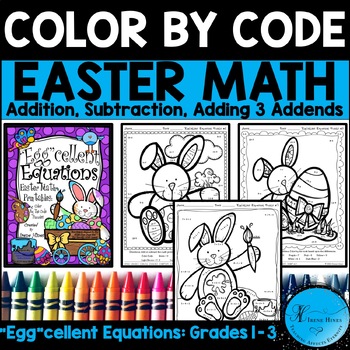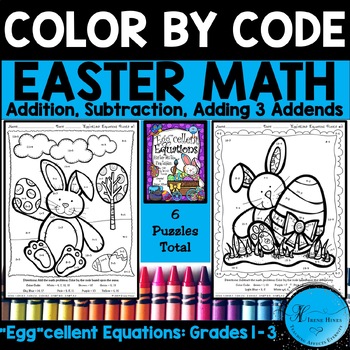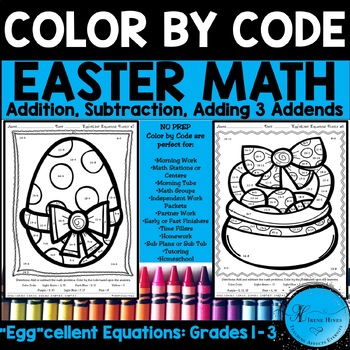Easter Math Color By Number Code Spring Addition & Subtraction Coloring Pages
- PDF
Also included in
- This NO PREP math bundle consists of addition, subtraction, multiplication and division color by the number code math worksheets for Kindergarten, First, Second, Third, and Fourth Grade. These coloring page puzzles can be use all year long, are aligned to the CCSS and each page has the specific CCSSPrice $79.00Original Price $227.00Save $148.00
- Math Color By The Code Collection: First and Second Grade Printable Puzzle Assortment to practice Addition and Subtraction Facts!This pack includes 8 of my color by the code math sets that are specifically geared towards First and Second Grade! There are a total of 48 puzzles for an entire year ofPrice $21.00Original Price $26.00Save $5.00
Description
Looking for a quick and engaging way to help your students practice addition and subtraction in the Spring? These Easter Color By The Number Code coloring pages are a FUN way to practice math facts! Your first, second and third grade students will love coloring by sum and difference!
► This resource, "Egg"cellent Equations, includes 6 math worksheets:
- Addition
- Adding Three Numbers
- Subtraction
- Answer keys included
- Aligned To The CCSS
- Each Page Has The Specific CCSS Listed
► NO PREP Color by the Number Code Worksheets are perfect for:
- Morning Work
- Math Stations or Centers
- Morning Tubs
- Math Groups
- Independent Work Packets
- Partner Work
- Early or Fast Finishers
- Time Fillers
- Homework
- Sub Plans or Sub Tub
- Tutoring
- Homeschool
▼▼▼▼▼▼▼▼▼▼▼▼▼▼▼▼▼▼▼▼▼▼▼▼▼▼▼▼▼▼▼▼▼▼▼▼▼▼
★ SAVE BIG BY PURCHASING THE STORE BUNDLE! ★
Click Here --> My Entire Store Of Color By Code Math Coloring Worksheets
▼▼▼▼▼▼▼▼▼▼▼▼▼▼▼▼▼▼▼▼▼▼▼▼▼▼▼▼▼▼▼▼▼▼▼▼▼▼
❤ Click HERE to follow my store and get notifications about my new resources and freebies! ❤
Thank you!
Irene Hines ❤️ Teaching Affects Eternity
_______________________________________________________________________
Copyright © Irene Hines. All rights reserved by the author.
This teaching resource is not for commercial use and is intended for classroom use only.
Permission to copy for single classroom use only.
Please purchase additional licenses if you intend to share this product.







